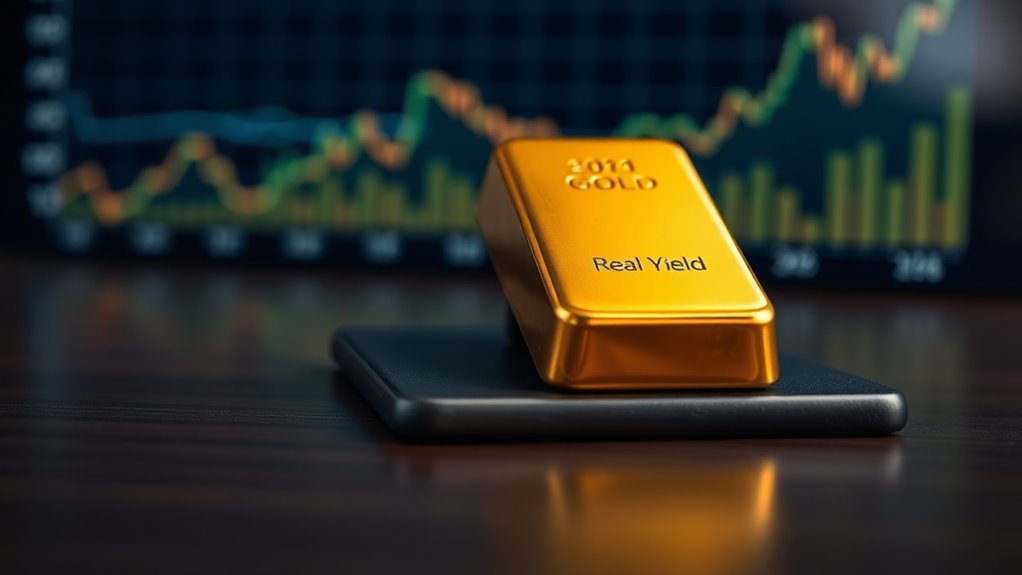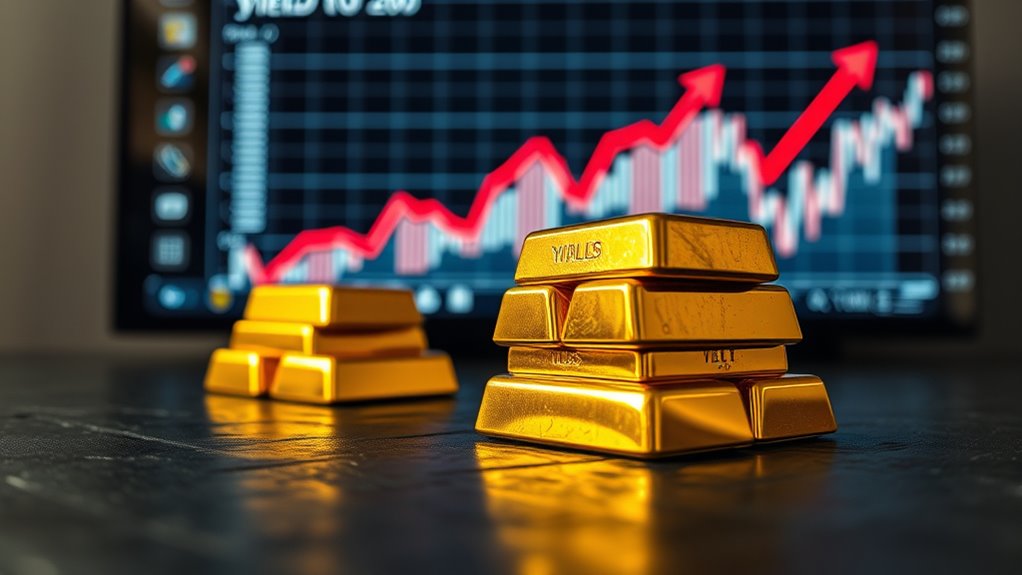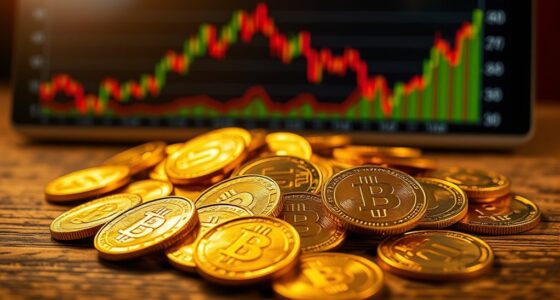When real yields rise, you’ll notice gold prices often decline because higher inflation-adjusted returns make interest-bearing assets more appealing. Gold isn’t paying interest, so as bonds and savings yields improve, gold becomes less attractive as a store of value. However, this isn’t the whole story—fiscal worries, economic uncertainty, and market sentiment can keep gold afloat or even rising despite increasing real yields. Want to understand how these factors interplay? Keep exploring to learn more.
Key Takeaways
- Rising real yields generally depress gold prices due to increased opportunity costs, but this relationship can be offset by economic or fiscal concerns.
- Gold acts as a safeguard during negative real yields, often rallying even when yields are rising if inflation expectations or uncertainty increase.
- External factors like fiscal stress, debt worries, or geopolitical events can support gold prices independently of yield trends.
- Market sentiment, investor risk appetite, and ETF flows can cause gold to diverge from the typical inverse relationship with real yields.
- Central bank policies and global economic outlooks influence both bond yields and gold, sometimes leading to unexpected price movements.

As real interest rates rise, gold prices typically decline due to the increased opportunity cost of holding non-yielding assets. When you see real yields climbing, it signals that the return on safe assets like bonds and savings accounts is becoming more attractive. This makes gold less appealing because it doesn’t generate interest or dividends. The strong negative correlation—around -0.82—means that as real yields go up, gold tends to fall. You should understand that this relationship isn’t perfectly linear; gold acts more like a wealth preservative when real yields are negative, especially during periods of inflation exceeding nominal interest rates.
In a scenario where real yields turn positive, you’re likely to see investors shift away from gold in favor of interest-bearing assets. Rising real yields increase the opportunity cost of holding gold, discouraging investment in the metal. This shift is especially pronounced when real yields move from negative to positive, reducing gold’s attractiveness as a safe haven and store of value. Conversely, when real yields are negative, gold often rallies as investors seek assets that preserve wealth amid erosion of cash and bond holdings. It’s during these times that gold shines, acting as a hedge against inflation and wealth destruction.
However, the relationship between real yields and gold isn’t solely dictated by interest rates. Fiscal and debt concerns, especially in the U.S., can support gold prices even when real yields rise. Increased worries about government debt sustainability or deficits push investors toward gold as a safe haven, sometimes offsetting the downward pressure from higher real yields. The spread between U.S. Treasury yields and interest rate swaps widens during fiscal stress, reflecting worries about debt and economic stability. These concerns can decouple gold prices from the typical inverse relationship with real yields, showing that sentiment, fiscal outlooks, and economic uncertainty also drive gold demand. Additionally, central bank policies and global economic conditions also influence the relationship, sometimes leading to unexpected movements in gold prices despite rising yields. Moreover, market participant behavior and speculative activity can further distort this relationship, making it more complex.
Market dynamics further complicate the picture. Rising Treasury yields often signal expectations of economic growth or inflation, which can dampen gold’s appeal. But during periods of economic uncertainty or recession threats, investors may favor gold as a defensive asset, even if yields are rising. Political events and policy shifts in major economies influence bond yields, which indirectly impact gold markets. Changes in sentiment, ETF flows, and risk perception can lead to simultaneous increases in Treasury yields and gold prices, highlighting that other factors can dominate pure yield effects. Moreover, market sentiment and investor behavior can sometimes override fundamental yield relationships, causing gold prices to diverge from typical patterns. Additionally, central bank policies and global economic conditions also influence the relationship, sometimes leading to unexpected movements in gold prices despite rising yields. The inflation outlook also plays a crucial role in shaping investor expectations and gold’s performance amid changing real yields.
Frequently Asked Questions
How Do Rising Real Yields Impact Other Precious Metals?
You might notice that rising real yields generally put downward pressure on precious metals like silver, platinum, and palladium because higher yields make interest-bearing assets more appealing. However, their impact varies—industrial demand for palladium and platinum can offset some effects, while silver, with its investment and industrial uses, might be more sensitive. Keep in mind, market sentiment and economic conditions also influence how these metals respond.
What Historical Periods Show Gold’s Divergence From Real Yield Trends?
This question is a goldmine of insights! Historically, gold has diverged from real yield trends during major economic upheavals, like the late 1970s inflation surge and post-2008 financial crisis. In these periods, despite rising or falling yields, gold prices soared due to heightened uncertainty, inflation fears, and central bank demand. These divergences show that gold reacts not just to yields but also to broader economic and geopolitical shocks.
Can Gold’s Performance Predict Future Movements in Real Yields?
You might wonder if gold can predict future real yield movements, but it generally can’t. Gold reacts to changes in real yields, not the other way around. When real yields fall, gold prices tend to rise, reflecting market expectations. However, gold’s performance isn’t a reliable indicator of upcoming yield shifts. Instead, look at macroeconomic signals and policy changes to gauge future real yield trends more accurately.
How Do Inflation Expectations Influence the Relationship Between Yields and Gold?
You see, inflation expectations shape how yields and gold interact. When investors anticipate higher inflation, they often buy gold as a hedge, which can lower real yields. This increased demand for gold makes it more attractive, especially if monetary policy keeps real rates low. But be aware, gold’s response isn’t straightforward; it depends on whether inflation expectations are driven by actual economic conditions or market sentiment.
What Are the Long-Term Effects of Sustained Rising Real Yields on Gold Investment?
You should consider that sustained rising real yields could eventually reduce gold’s appeal as an inflation hedge, making it less attractive compared to income-generating assets. However, the long-term outlook remains positive if geopolitical tensions and economic uncertainties persist, supporting demand. Diversification remains key, and you’ll want to monitor shifts in investor behavior, central bank policies, and global risk factors that could influence gold’s role in your portfolio over time.
Conclusion
So, don’t let headlines scare you into thinking gold’s doomed. Imagine holding onto a shining treasure, even as real yields climb—its value still shimmering through the noise. Rising yields might slow down gold’s recent gains, but they won’t erase its role as a safe haven. Keep a clear eye; gold’s resilience lies in its ability to adapt and shine, even when the economic skies look a bit stormy.
Helen brings a wealth of experience in investment strategy and a deep passion for helping individuals achieve their retirement goals. With a keen understanding of market dynamics, Helen has been instrumental in shaping the vision and direction of Gold IRA Markets. She specializes in creating innovative solutions that align with our clients’ long-term investment objectives.










